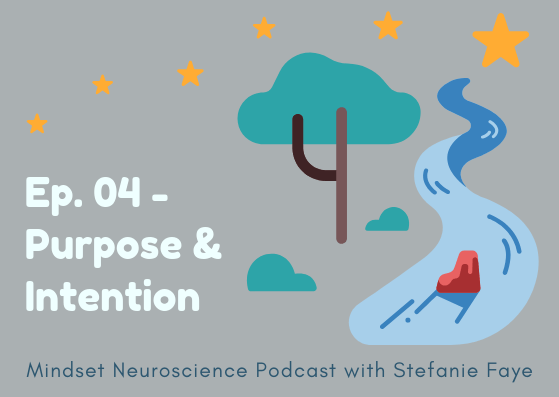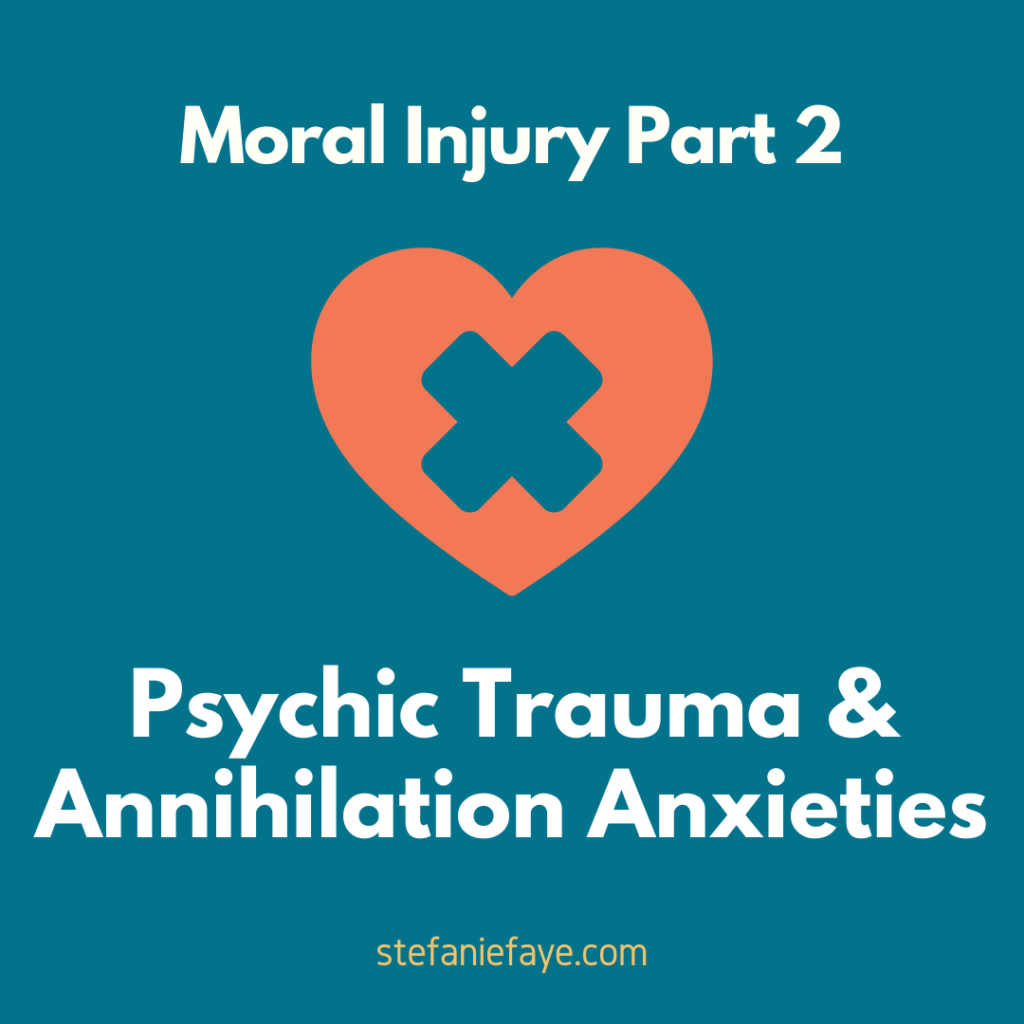 Psychic trauma, annihilation anxiety and moral injury reveal fears about how our life and existence is valued by others.
Psychic trauma, annihilation anxiety and moral injury reveal fears about how our life and existence is valued by others.
Using the example of being ‘chased by a tiger’ to describe fear doesn’t resonate
Something that has come to the forefront in my coaching this past year is that many people are feeling a sense of anxiety, discomfort or something ‘off’ that they can’t quite put their finger on.. They know they’re not living their highest potential, but they can’t figure out what it is that holds them back. They’ve been doing personal development for years.
They know about the concept of fear, and that we have primitive systems that make us believe we’re being ‘chased by a tiger’ even when we’re not. But there’s something missing from all this talk about fear that isn’t resonating with many people’s experience.
The reason for this is that it’s less about a fear of death - and more about how their life and existence is valued by others.
Through conversations with many clients over the past year, I have found that the unease they are feeling and what blocks them from getting to their next level is tied more closely to what is called psychic trauma, annihilation anxiety and moral injury (for Part 1 of this series on Moral Injury, click here)
The words that come through during these explorations are:
- Guilt
- Shame
- Betrayal
- Fear of Abandonment
- Fear of Enmeshment
- Fear of Retaliation
- Fear of being Condemned, Judged or Punished
This is reflected in a concept called Annihilation Anxiety, which can include fears of:
- being overwhelmed, unable to cope and losing control
- merger, entrapment or being enmeshed or consumed by another
- disintegration of self or identity, emptiness, meaninglessness, nothingness
- impingement or violation
- abandonment and need for support
- survival, persecution, punishment and catastrophe
Psychic Trauma and its related fears have a philosophical or existential flavor to them.
They’re hard to describe, but once someone is able to identify that their fear, sadness, rage, overwhelm or hopelessness is tied to one of these types of psychic anxieties, they are able to explore this in new ways that can help them get to a place of internal safety and peace beyond anything they have experienced before. I’ll continue to do my best to help you understand how to get there. It’s a big and complex topic, so I’ll break it down in this post by explaining some theories from people working in the field of trauma resilience and moral injury.
If we were to keep using the example of being chased by a tiger, it would be more resonant for many people to pinpoint why being chased by a tiger has such a lasting and lingering effect on their nervous system.
The way to truly resonate with the human experience of fear is to acknowledge that along with having a parasympathetic and sympathetic nervous system, we have a Social Nervous System.
When we are faced with challenges and dangers, the lasting physiological imprints from these events are deeply tied to the meaning we make about how we are supported and valued by others, as well as what we contribute and how we are needed.
If a person was being chased by a tiger… the actual deeper, darker feelings of fear that will continue to haunt them long afterwards may be tied to the idea that if they were being chased, it may mean that they were being abandoned, betrayed, punished or no longer needed by their tribe, family or social group. Fears that are tied to this may be related to our own shame and guilt about not being enough.
As is described by Litz, Lebowitz, Gray and Nash in their book Adaptive Disclosure: A New Treatment for Military Trauma, Loss, and Moral Injury:
“Even when service members develop a life-threat-based stress injury in theater, arguably the most pressing problem is not high states of fear and arousal, but rather the self-condemnation and guilt that may arise from letting peers and leaders down because of a perceived or real temporary incapacitation in the field.”
By now, you’ve likely heard of trauma and post-traumatic stress (PTS). Much of PTS research and tools are focused on the physical danger side of threat. Some therapists and researchers such as Bill Nash and Ruth Lanius discovered as they were working with PTS patients, however, that another element beyond fear was affecting them...
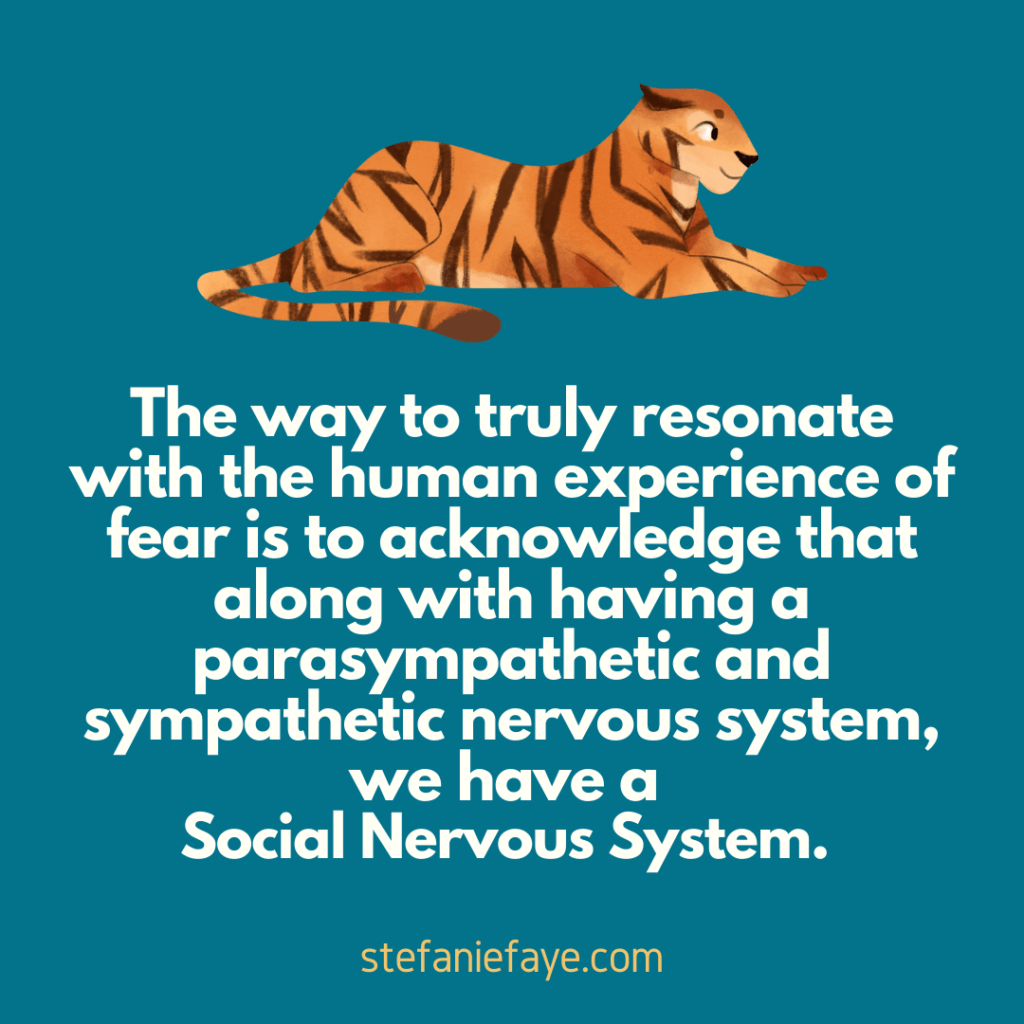
“They’ll see the stain on my soul”
In an interview with TVO, Ruth Lanius describes one of her patients, a war veteran, having difficulty looking her in the eye. She asked if he could tell her about this, to which he replied ‘I cannot look anyone in the eye for fear that they will see the stain on my soul.’ This was one of the turning points for Lanius to begin looking at what is called Moral Injury. This path was inspired by the work of Nash, who co-authored the book Adaptive Disclosure:
In the framework of Adaptive Disclosure, practitioners ask service members to identify an experience that is currently “haunting or consuming them”. This experience is categorized as a:
- life-threatening event
- traumatic loss or
- moral injury
Moral injury is further subdivided into:
- bearing witness to
- perpetrating or
- failing to prevent …
… events that transgress deeply held moral beliefs and expectations. Moral injury focuses on symptoms related to guilt, shame, anger, disgust and betrayal.
Moral Distress and ethical dilemmas
Philosopher Andrew Jameton’s first explored the concept of moral distress in his book on nursing issues, Nursing Practice: The Medical Issues. In this book he describes moral distress as the psychological conflict nurses experienced during "ethical dilemmas". He wrote that "moral distress arises when one knows the right thing to do, but institutional constraints make it nearly impossible to pursue the right course of action."
Psychiatrist Jonathan Shay and colleagues later coined the term Moral injury to reflect military/veteran patients’ perception of injustice as a result of leadership malpractice.
Litz and colleagues then expanded on this concept as "perpetrating, failing to prevent, or bearing witness to acts that transgress deeply held moral beliefs and expectations may be deleterious in the long term, emotionally, psychologically, behaviorally, spiritually, and socially"
These frameworks expand beyond first responders’ experiences and into something that is embedded into the collective human narrative and subconscious:
the witnessing of, participating in or failure to prevent situations that relate to life threat, loss and moral injury (knowing that what is being done is ‘not right’).
When we witness, contribute to or fail to prevent an event that is socially or physically dangerous to another person, this triggers a loss of agency. If we are a part of a system that is operating in this harmful way, our nervous systems must stay alert and vigilant to the possibility that we or our loved ones can also be harmed, retaliated against or discarded.
In the realm of annihilation anxiety, when something distressing occurs and we feel that:
- we are to blame for it
- we didn’t do enough to stop it
- we were betrayed, unsupported or abandoned
- we were responsible for someone else’s wellbeing beyond our capabilities
… these all contribute to a lingering experience of something being wrong. It’s a visceral sensation that there is some kind of pain we want to avoid at all costs.
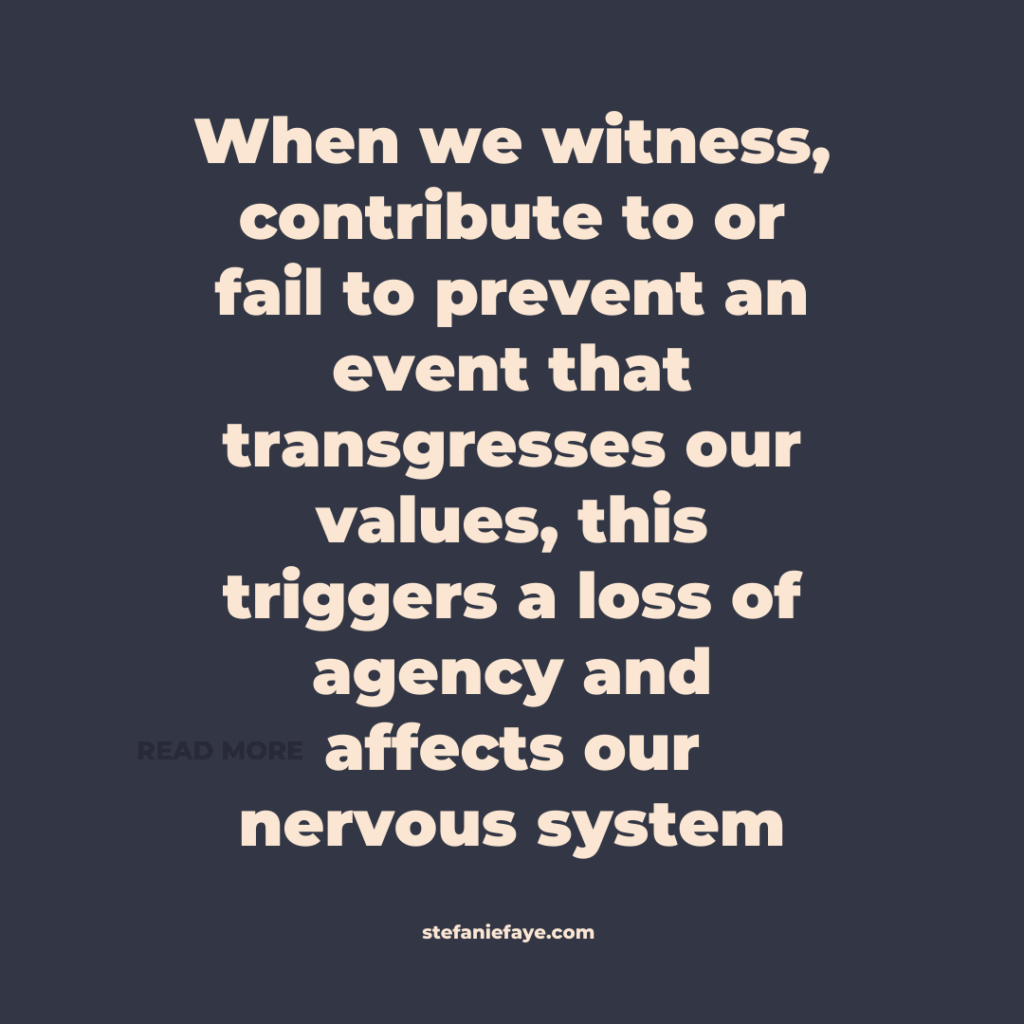
Pause for a moment to think about how many individuals and communities in the world can relate to one or more of these experiences.
In my view, the idea of moral injury and psychic anxiety is tied to anything that diminishes the integrity of not only the individual physical vehicle, but the integrity of social strands that connect us as cells of a planetary-wide-species-organism. Tribalism and intergenerational trauma are aspects of human society that contribute to this.
When you feel an overreaction or extreme sense of distress about something… see if you can explore what the story is behind this.
Is it tied to one of the anxieties listed in the top section of this post?
Just having an awareness of this can help create space for self-reflection and exploration of how we may release some of the deeper meaning our social nervous system stores within us.
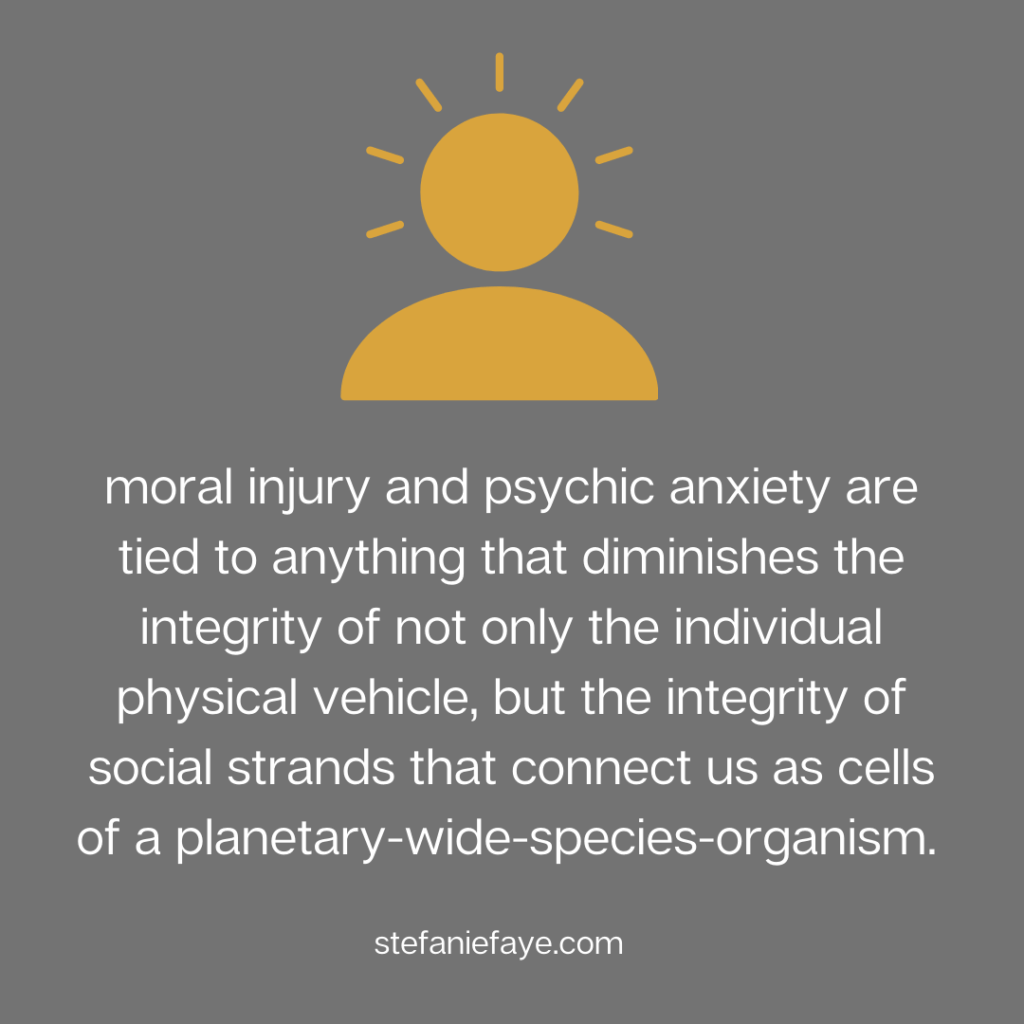
In the next post, I’ll cover ideas being used to help us mitigate the negative impacts of psychic trauma, annihilation anxieties and moral injury.
In the meantime, I encourage you to look at the work of Ruth Lanius and William Nash and colleagues. Lanius is exploring MRI imaging, neurofeedback and therapies for noticing and processing emotions and bodily sensations, such as tension in the head and neck (often associated with moral injury).
Nash’s work on Adaptive Disclosure offers ideas of how we can process and release the pain of guilt, shame, self-condemnation, rage and other negative emotions associated with moral injury.
In the book Adaptive Disclosure, he and his co-authors offer a useful summarization of three types of Principal Harms (threat, loss and moral injury), along with how these manifest and the corrective elements that can help alleviate these symptoms of distress. I’ll cover these in February's article.
References:
Dowling, S. (1986). Discussion of the various contributions. In Rothstein, 1986, op cit., pp. 205-
- Rothstein, ed. The Reconstruction of Trauma. Madison, CT: International Universities
Press..
TVO interview with Ruth Lanius: https://www.tvo.org/article/what-is-a-moral-injury-and-how-can-it-be-treated
Adaptive Disclosure: A New Treatment for Military Trauma, Loss, and Moral Injury by Brett T. Litz, Leslie Lebowitz, Matt J. Gray, William P. Nash
Jameton A. Nursing practice: the ethical issues. Englewood Cliffs, NJ: Prentice Hall, 1984
Litz, Brett T.; Stein, Nathan; Delaney, Eileen; Lebowitz, Leslie; Nash, William P.; Silva, Caroline; Maguen, Shira (December 2009). "Moral injury and moral repair in war veterans: A preliminary model and intervention strategy". Clinical Psychology Review. 29 (8): 695–706.
Shay, J. (2010). Achilles in Vietnam: Combat Trauma and the Undoing of Character. Simon & Schuster

